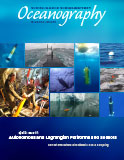Article Abstract
Autonomous and Lagrangian platforms and sensors (ALPS) have revolutionized the way the subsurface ocean is observed. The synergy between ALPS-based observations and coupled ocean-sea ice state and parameter estimation as practiced in the Arctic Subpolar gyre sTate Estimate (ASTE) project is illustrated through several examples. In the western Arctic, Ice-Tethered Profilers have been providing important hydrographic constraints of the water column down to 800 m depth since 2004. ASTE takes advantage of these detailed constraints to infer vertical profiles of diapycnal mixing rates in the central Canada Basin. The state estimation framework is also used to explore the potential utility of Argo-type floats in regions with sparse data coverage, such as the eastern Arctic and the seasonal ice zones. Finally, the framework is applied to identify potential deployment sites that optimize the impact of float measurements on bulk oceanographic quantities of interest.

